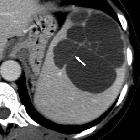Generalized lymphatic anomaly


Generalized lymphatic anomaly, previously known as lymphangiomatosis or cystic angiomatosis, is a systemic condition characterized by multifocal lymphatic malformations with systemic distribution. The distribution of lesions is variable; there can be cutaneous, thoracic and abdominal viscera and osseous involvement.
There is overlap in appearance and presentation with Gorham-Stout disease, in which lymphatic malformations classically result in progressive osseous destruction (thus the moniker "disappearing bone disease"). By contrast, the osseous lesions seen in generalized lymphatic anomaly tend to be centered in the medullary space, and are less prone to causing progressive cortical destruction.
Terminology
Classification and nomenclature of vascular and lymphatic malformations have changed over time to reflect an evolving understanding of the pathology and genetic underpinnings. Invasive lymphatic malformations have historically been known as "congenital lymphangiomatosis", "disseminated lymphatiomatosis", "multifocal lymphangiomatosis", or "cystic angiomatosis" . The current terminology reflects an acknowledgement that the underlying lesions are lymphatic malformations, and also non-proliferative lesions (and so terminology with "-osis" is discouraged).
The International Society for Study of Vascular Anomalies (ISSVA) endeavors to provide a hierarchical classification schema in order to standardize terminology beyond the World Health Organization classification of soft tissue / vascular tumors. According to the most recent 2014 ISSVA update, "generalized lymphatic anomaly" specifically refers to multifocal lymphatic malformations which may affect the superficial soft tissues, thoracoabdominal viscera, and bones .
Epidemiology
Generalized lymphatic anomaly is a rare congenital disease .
Clinical presentation
As opposed to Gorham-Stout disease, osseous lesions of generalized lymphatic anomaly are less likely to be symptomatic , although either can potentially present with pathological fracture .
Pathology
In general, lymphatic malformations consist of abnormally dilated lymphatic channels lined by endothelial cells, specifically of a lymphatic phenotype .
Location
Osseous involvement is typically polyostotic, and are most commonly located in the axial and proximal appendicular skeleton.
Visceral involvement is variably present, and most commonly involves the spleen . Liver, kidneys, lung, mediastinum, neck, axilla, and retroperitoneum may also be involved.
Microscopic appearance
Histopathologic analysis of osseous lesions shows variably sized lymphatic channels within both medulla and cortex. Involved bone surfaces variably show osteoblasts surrounding larger channels, and the lesions are relatively free of destructive osteoclasts and with few Howship’s lacunae. The marrow stroma shows mild fibrosis and inflammatory change. Beyond of bone, there are often abnormal lymphatic channels in the soft tissue surrounding the bone .
Radiographic features
The imaging appearance of generalized lymphatic anomaly recapitulates the typical features of lymphatic malformation, namely multiseptated cystic mass lesions which tend to insinuate and invade adjacent normal structures. The distribution of malformation is variable, and may involve:
- unilocular or multiseptated cystic lesion
- pulmonary interstitial nodules
- diffuse pulmonary interstitial thickening
- chylous pleural effusion
- lytic ("cystic") bone lesions:
- both axial and appendicular skeleton commonly involved
- thoracic spine, ribs, humerus, femur, scapula
- may increase in size and number over time, but generally, do not demonstrate progressive osteolysis
- both axial and appendicular skeleton commonly involved
Treatment and prognosis
There is not a standard treatment. Surgical resection, radiotherapy, chemotherapy, and sclerotherapy have been used . Rare cases have been associated with mortality.
Differential diagnosis
The differential diagnosis for multiple lytic bone lesions includes:
- Langerhans cell histiocytosis (LCH)
- lytic bony metastases
- multiple myeloma
- polyostotic fibrous dysplasia
- multiple enchondromatosis
- brown tumors of hyperparathyroidism
- multifocal osteomyelitis (in particular tuberculosis)
See also
Siehe auch:
und weiter:

 Assoziationen und Differentialdiagnosen zu zystische Angiomatose:
Assoziationen und Differentialdiagnosen zu zystische Angiomatose:




